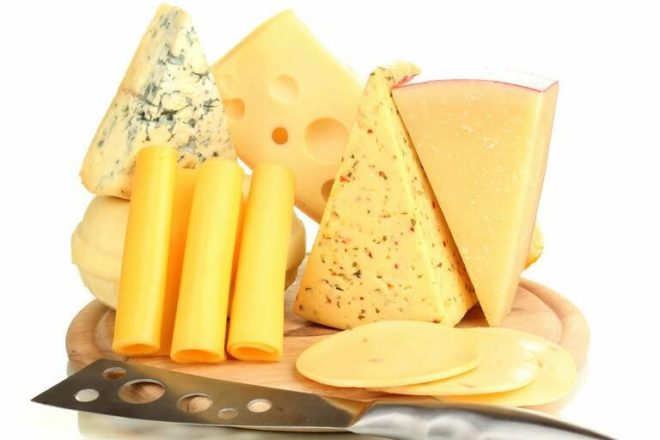Content
- 1 Cheese composition
- 2 Nutritional value and calorie content of cheese
- 3 Useful properties of cheese
- 4 The benefits of cheese for women
- 5 Cheese for pregnant and nursing
- 6 Why cheese is useful for men
- 7 The benefits and harms of cheese for children
- 8 Is cheese possible with diabetes
- 9 Is cheese good for losing weight
- 10 Which cheese is healthier: hard or soft
- 11 Why homemade cheese is useful
- 12 Homemade cheese recipe
- 13 How much cheese can you eat per day
- 14 Harm of cheese and contraindications
- 15 How to choose and store cheese
- 16 Conclusion
The benefits and harms of cheese cause a lot of controversy among consumers: those who like to enjoy this product, intended not only for the festive, but also for the everyday table, appreciate the variety of its tastes and forms, others consider it too high in calories and eat with caution. Despite the differences of opinion, the benefits of cheese for the human body have been confirmed by scientific research.

Cheese composition
The composition, benefits and harms of a particular variety depend on many indicators, among which the method of production of the product is important: rennet or sour milk. The raw materials used - milk, cottage cheese - also affect the taste. In cheese making, cow and goat milk is most often used, a little less often - sheep's milk.
In general, the product includes:
- water, mass fraction of which is 42-48%;
- milk fat - 45-50%;
- salt - 1.5-3.5%;
- the rest is protein.
Nutritional value and calorie content of cheese
The nutritional value of the main groups of cheeses is tabulated for clarity.
Table 1 - Nutritional value
|
Cheese |
Proteins,% |
Fats,% |
Carbohydrates,% |
|
Rennet solid |
23,4-26,8 |
27,3-32,2 |
3,5 |
|
Solid, low fat |
28,3-31 |
9-15,2 |
0 |
|
Pickle |
14,6-19,5 |
20,1-25,5 |
3,5 |
|
Soft |
16,7-21 |
25-30,3 |
0 |
|
Fused |
20,5-23 |
19-27 |
0 |
In addition to proteins, fats and carbohydrates, the product contains many vitamins, trace elements and amino acids.
Cheese is considered one of the most high-calorie foods. Calorie content of cheese per 100 g: varieties with low fat content contain 240 kcal, and in its fatty types - 350-400 kcal. The energy value also depends on the specific variety and can be 10-18 kJ per 100 g.
Useful properties of cheese
The benefits of cheese are due to its rich nutritional composition. You can consider the positive effect of its individual components on the human body:
- Benefits for bones. The use of the product is an excellent prevention of osteoporosis. Vitamins A, D, K present in it, as well as calcium, magnesium, protein and zinc strengthen bones.
- Beneficial properties for blood and blood vessels. It helps to increase the level of hemoglobin in the blood, increases blood pressure, therefore it is one of the most indispensable foods for hypotension.
- Benefits for the gastrointestinal tract. Eating cheese promotes the growth of beneficial bacteria in the intestines. Brie and Camembert varieties have a beneficial effect on performance.
- Impact on mental state. The product has an anti-stress sedative effect, normalizes sleep in case of insomnia.
- Beneficial properties for the eyes. The high vitamin A content improves vision.
The constant consumption of cheese is recommended for patients with tuberculosis.

The benefits of cheese for women
This fermented milk product is useful not only for women's health, but also for beauty:
- Hair care properties. Zinc, which is one of the components, prevents premature hair loss by strengthening the hair follicles. Calcium restores dry and brittle hair. And vitamin A makes them shiny and healthy.
- Benefits for the skin. The B vitamin found in cheeses gives the skin a firm, healthy glow and helps get rid of all sorts of blemishes.
- Useful properties for teeth and nails. The product is rich in calcium, therefore it has a positive effect on the appearance of teeth and nail plates. In addition, it contains compounds that reduce acidity, so lovers of the product rarely experience caries and wear of tooth enamel.
Cheese for pregnant and nursing

Pregnant women can eat some species in which there are no conditions for the appearance and reproduction of harmful bacteria. This group includes all hard varieties and some soft (feta, Philadelphia, processed, curd, mascarpone). It is undesirable to use this fermented milk product with mold, with unpasteurized milk included in the composition. This condition applies exclusively to fresh consumption; during heat treatment, these cheeses can also be used for food.
The benefits of cheese for breastfeeding, in addition to all the above advantages, are based on the optimal ratio of calcium and phosphorus included in its composition. It is in the presence of the last element that calcium is absorbed by the female body as much as possible, and subsequently by the child.
During breastfeeding, women should preferably eat goat cheese rather than cow's milk. Women who are breastfeeding are advised to eat species that meet the following requirements:
- low fat content (no more than 20%);
- with a short ripening period (young);
- low salt content - with an excess of this component, milk production worsens;
- without any additional flavors and mold - such products cause abdominal pain, diarrhea and poisoning in newborns.
Why cheese is useful for men
Some types of low-calorie cheeses can increase male potency and help in the fight against other problems with male sexual activity: feta cheese, feta, ricot, suluguni. Other types with high calorie content, on the contrary, are harmful: they can reduce potency, increase blood cholesterol levels and contribute to obesity.
The benefits and harms of cheese for children
Cheese is very useful for a child - it strengthens the bones of the growing body and contributes to their proper development. But there are also negative properties of it - it often causes allergic reactions in children and is considered difficult to digest. In order not to harm the baby, there are some rules for introducing it into the diet.
How and when to give cheese to a child
You can start giving the product to a child at the age of 2 years. The first portion should not exceed 5 g, so cheese is added to the main course for children. If no harmful effect is manifested after its use, then from 3 years old the child can eat cheese as a separate dish.
Is cheese possible with diabetes
Diabetics can eat cheese in moderation, as it does not cause spikes in blood sugar: glucose is released gradually.Since this group of people is at risk of cardiovascular disease, it is recommended that they eat low fat and low salt species.

Is cheese good for losing weight
For people on a specific diet for weight loss, cheese should be included in the diet - it will help maintain muscle mass and health. In this case, special attention should be paid to the calorie content of the selected variety - it should be low-fat, up to 20%. A low-fat product inhibits the absorption of carbohydrates, thereby helping to fight excess weight.
Which cheese is healthier: hard or soft
Soft cheeses are healthier due to their increased biological value - some proteins contained in them are absent in hard varieties of the product. The composition of the solid product is distinguished by the presence of many important amino acids that the human body needs, but is not able to produce on its own.
Why homemade cheese is useful
Homemade cheese is considered more useful than purchased cheese: there is no doubt about the quality of selected products, the amount of salt and fat content can be controlled independently. All vitamins and nutrients of the milk used are also preserved. Housewives often improve the flavor of the product by adding a variety of spices and seasonings.
Homemade cheese recipe
Below is a simple step-by-step recipe for making hard cheese at home:
- 700 g of cottage cheese is poured into a saucepan and the lumps are kneaded, after which 1 liter of milk is poured and put on low heat.
- The mass is constantly stirred until the cottage cheese becomes solid and the liquid whey turns yellowish. After that, the pan is removed from the heat, and the curd is dried on gauze.
- The bottom of the pan is greased with 2 tbsp. l. butter, set on the lowest heat, add cottage cheese, 2 eggs, 2 tsp. salt, 1 tsp. soda and stir for 30 minutes. (less time is needed when using soft curd).
When a homogeneous consistency is reached, it is laid out in a mold covered with a film, and removed to a cool place until it solidifies.

How much cheese can you eat per day
The benefits and harms of cheese for human health affect the recommendations for its daily consumption. In general, the optimal daily intake of this sour-milk product is considered to be 30-50 g. It is also important to take into account other dairy products eaten per day, for example, you can eat up to 50 g of cheese or up to 150 g of cottage cheese or drink up to 0.5 liters milk or kefir.
Harm of cheese and contraindications
The use of the product has its own contraindications. Cheese is not recommended for groups of people suffering from high cholesterol levels and acute gastrointestinal diseases.
The harm of the product in the general case lies in its consumption in large quantities. Daily overeating can result in migraines, insomnia, and spikes in blood pressure.
How to choose and store cheese
You need to choose a product based on its appearance, consistency, taste and smell. The hole-eyes should be evenly distributed throughout the piece, the cut should be dried and not let out liquids, the color of the product should be even. To check the consistency, you need to lightly press your finger on the selected piece: if a dent forms, then you should abandon the purchase.
You need to store the product in the vegetable compartment in the refrigerator, wrapped in plastic wrap and a plastic bag. The shelf life of hard varieties is no more than 10 days, soft varieties - up to 3 days. Under improper storage conditions, cheeses lose their valuable properties and turn into a favorable environment for the development of bacteria.
Conclusion
The benefits and harms of cheese for certain groups of people can cause the desire to consume the product every day, or, conversely, completely abandon it. You can learn more about the benefits and dangers of the product by watching the video:

